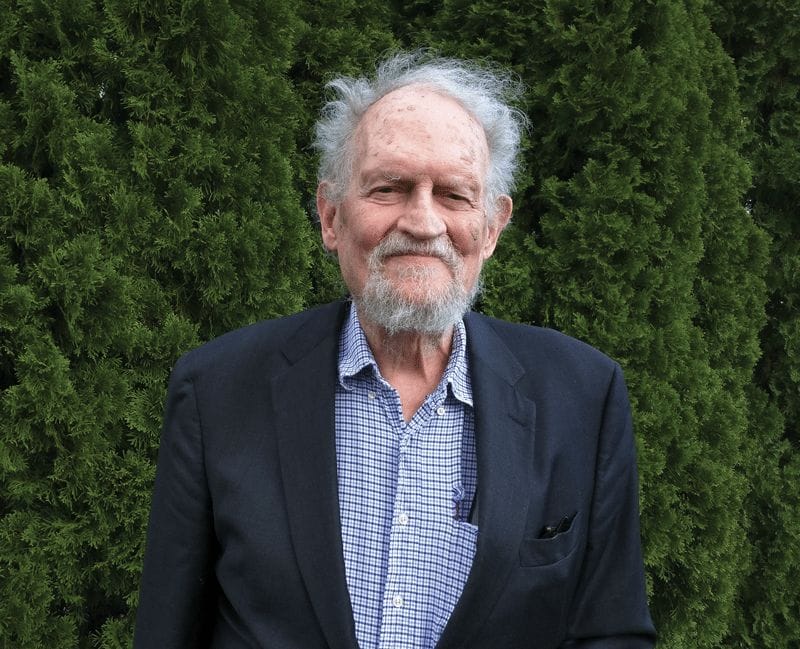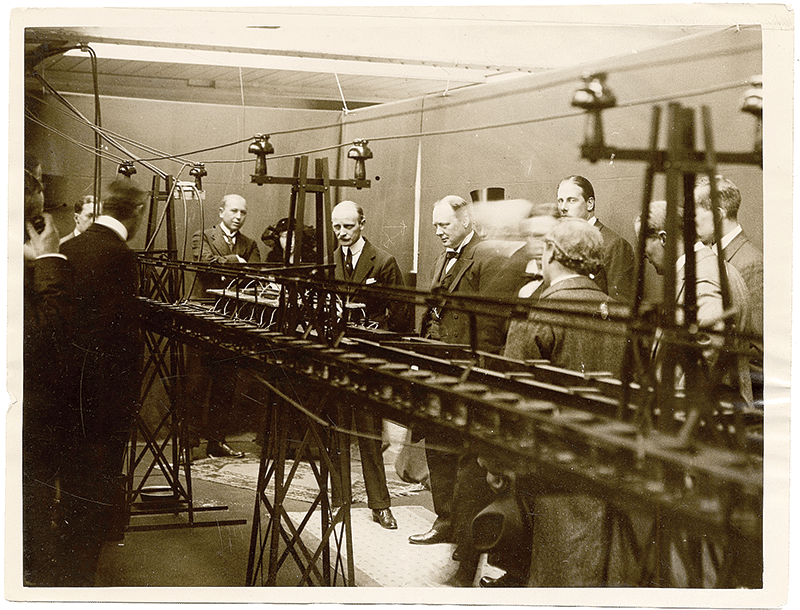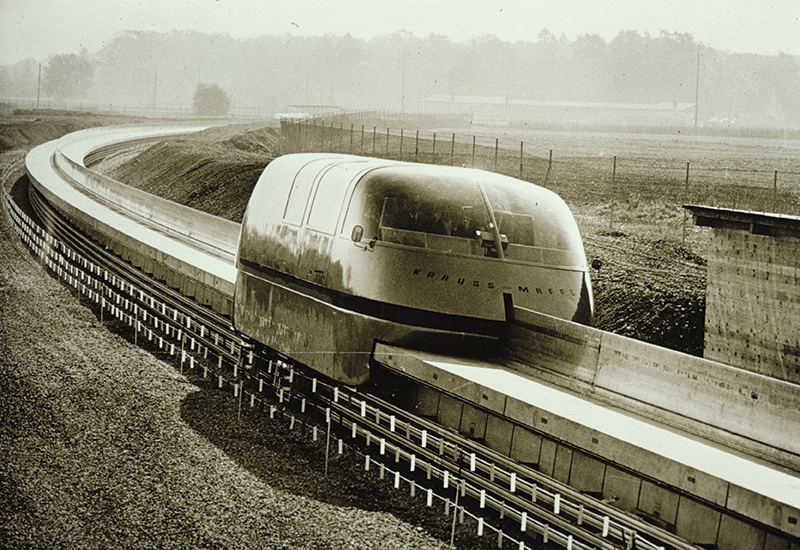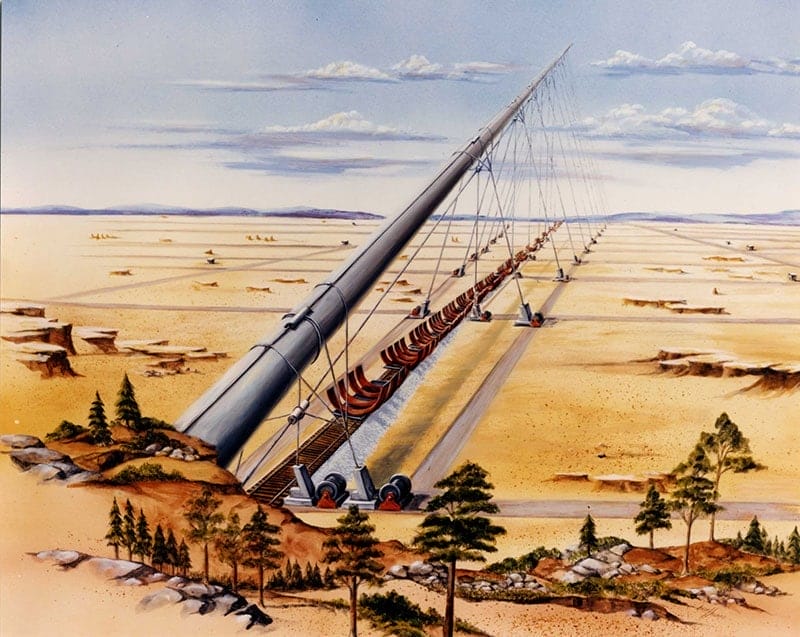Train of thought
As Japan’s maglev train sped into the record books in April 2015, Loes Witschge tracked the technology’s 111-year history and the space-based plans for its future

A concept painting of StarTram, a proposed launch system that would use magnetic levitation to shoot cargo – and eventually humans – into space. Image courtesy of Dr John Rather
21st April 2015 (Taken from: #19)
Floating ten centimetres above the ground and powered by superconducting magnets, the L0 Series test train tore through the countryside around Mount Fuji on 21st April.
Five days earlier it had set a new speed record of 590 kilometres an hour and now the eyes of its 49 passengers, all employees of the Central Japan Railway Company, were glued to the speed display as it broke the 590 mark and inched towards 600. Monitors at the front of each carriage showed the dizzying view from a camera on the train’s nose, a blurred panorama in which a mile of landscape sped by every ten seconds. The train accelerated still further, breaking through 600 kilometres an hour – two and a half times faster than the top speed of the fastest train in the US – and, for a few glorious, discombobulating seconds, hitting 603 on the dial before easing back down again.
It was an amazing moment for Japanese engineering and Japanese pride. And it almost didn’t happen.

2015: Japan’s 600 km/h L0 Series maglev train. Photo: AP/Press Association Images
On 18th January 1966 James Powell, the inventor of the technology behind the superconducting maglev (magnetic levitation) train which zipped into the record books around Mount Fuji, was 11,000 kilometres away at the Brookhaven National Laboratory on Long Island, New York. He was happily working at his desk when his colleague Michael Maresca strode in with a shotgun and shot him in the chest.
“He was a good guy, but he was sort of paranoid and he believed that the people at the lab were radiating him and shrinking his testicles,” Powell recounts in a strikingly casual manner. “So he came in, naked from the waist up, with symbols painted over himself and a shotgun. He ran into the lab and he shot me and a couple of other people.”
Maresca shot three lab employees and missed a fourth before walking back outside, putting the barrel of his gun in his mouth and firing one last time. He fell dead a few feet from his station wagon, its motor still running.
He was happily working at his desk when his colleague Michael Maresca strode in with a shotgun and shot him in the chest”
Powell still has several shotgun pellets lodged inside his chest, one of them only a millimetre from his aorta. It reminds him of how lucky he was to survive that day. He and the two others who were shot made a relatively swift recovery. Later that year, Powell and his colleague Gordon Danby published a paper about an idea they had been working on together – of a train that would float in the air, suspended and propelled above its track by superconducting magnets. They were awarded a US patent for their invention three years later.
“If I’d died I’d have never got to publish [the paper],” Powell says. “It shows how random things are and how things can just happen in a matter of seconds.”
Powell is now 83, with a shock of grey hair and the same full goatee he has sported for much of his life. When I speak with him he is joined by his son Jesse, 48, who has a PhD in oceanography but decided to join his father in dedicating himself to furthering maglev. Powell can lose himself in the deep detail of his plan for a maglev for America: whenever he veers off track, Jesse affectionately brings him back on point.

James Powell in 2015. Photo courtesy of James and Jesse Powell
The idea of maglev came to Powell in the early 1960s on a Friday night. He was on his way from Long Island, New York, to see his girlfriend in Boston when he got stuck in a five-hour traffic jam on the Throgs Neck Bridge, which connects Queens to the Bronx. At the lab, Powell had been working with superconductors – materials, mostly metals, which dramatically lose their electrical resistance when cooled, allowing current to flow with virtually no energy loss. One property of superconductive materials is that when they are in this state of near-zero resistance they can create powerful electromagnetic fields – strong enough to repel objects as large as passenger trains and keep them suspended in mid air.
“I thought, ‘Gee, you have all these very strong forces. Why not just use this to levitate something that can travel very fast without contact to the ground’,” says Powell. “The idea happened right on that bridge.”
Powell wasn’t the first to conceive of a train levitated and propelled by magnetic forces. Robert Goddard, the US rocket scientist who went on to create the first ever liquid-fueled rocket in 1926, wrote a paper outlining the idea as a college freshman in 1904. Ten years later, French-born American engineer Emile Bachelet demonstrated the first model of a magnetic train to dignitaries including Winston Churchill and the lord mayor of London. Bachelet had already obtained a patent for his idea, but never got to realise his vision because the electrical power it required made it economically unfeasible at the time.

1914: Emile Bachelet demonstrates the first working model of a magnetic train to Winston Churchill in London. Photo: Archives Center, National Museum of American History
Powell and Danby finally solved Bachelet’s problem by introducing superconducting magnets into the equation. The pair were sharing a house in Patchogue, New York, in the 1960s. In the evenings, they would talk about their work at the lab and, after Powell’s revelation on the bridge, they spent their spare time hammering out the details of their superconducting maglev concept.
When Powell and Danby published their paper, other scientists and engineers started flocking to the lab to talk about maglev. “I thought it was a neat thing as a concept for the future. But we didn’t work out an idea of how it would evolve,” Powell recalls. “I was quite surprised when, after we published it, we got a tremendous number of calls from the Department of Transport. It really caught fire.”
Maglev promised to be a much faster alternative to regular trains because there was no contact, and therefore no friction, between the carriages and the tracks. No friction also meant a far smoother ride than in conventional trains. In the first years after the paper’s publication, modest amounts of US federal funds were put into maglev research. But progress soon ground to a halt. The Gerald Ford administration of the mid-1970s decided to cut funding for high-speed initiatives and instead focus on improving America’s existing railroads and mass transit systems.
To the frustration of Powell and Danby, development of maglev in the US came to a near-standstill for more than a decade. In the late 1980s, hopes were briefly restored when the pair found a powerful ally in Senator Daniel Moynihan of New York, who, in a 1989 essay for Scientific American, predicted that “[maglev] will define the coming century much as the railroad defined the last one, and the automobile and airplane have defined this one.” Moynihan shepherded a bill through Congress authorising $725 million for the development of a maglev prototype. But the funds were never appropriated by the relevant committee, which was chaired by Robert Carr, a representative from Michigan with links to the automobile industry. Since then, funding for a US maglev has been piecemeal, and Powell and Danby’s continuous efforts have seemed quixotic at times.
Meanwhile, outside the US, funding for the development of maglev has been more consistent, but the results it has yielded have been mixed. Birmingham airport in the UK was the first to open a commercial maglev railway in 1984. Using conventional electromagnets, the shuttle ran the 600-metre stretch between the airport and the railway station at 26 mph. The project got off to a bad start when a contractor added an extra layer of glass fibre to the vehicle to make it stronger. It made the vehicle too heavy to be lifted by the magnets and the whole thing had to be rebuilt from scratch.

1984: The world’s first commercial maglev at Birmingham airport. Photo: Nigel Tout
After 11 years of fairly erratic service, the train was abandoned in favour of a shuttle bus. One of the maglev carriages stood at a disused part of the airport until November 2010, when it was put up for auction on eBay, with the intention that the proceeds would be donated to charity. The carriage was bought for £25,100, but when the bidder failed to come up with the money, it was put on eBay again and a former engineer from Kenilworth, UK, ended up accidentally buying it for £100. Andy Jones, 60, had hoped that placing an opening offer would start a bidding war which would benefit good causes. But no one else was interested. “As a consequence I’ve got a five tonne train in the field opposite my house and I’ve got to find a suitable use for it,” he told the Coventry Telegraph at the time.
Germany invested more heavily in its high-speed Transrapid system. Its technology is based on a different principle for magnetic levitation that also works with normal electromagnets and was patented by German engineer Hermann Kemper in 1934. Several generations of Transrapid trains were tested on the Emsland test facility in western Germany where passengers would pay to experience top speeds of 450 km/h on the 31.8-kilometre track.
Then, on 22nd September 2006, tragedy struck. A Transrapid 08 train on a trial run collided with a maintenance vehicle at almost 200 km/h. Twenty-three people were killed and another ten were injured. Human error was blamed for the first fatal accident in maglev’s history and manned trials were abandoned. In late 2011 the facility’s operation licence expired and a few months later the demolition of the track was approved.

1969: Germany’s Transrapid project, developed in the country until 2011. Photo: Siemens AG
Only in Japan have engineers been able to realise Powell’s vision. After success with its Shinkansen bullet trains in the 1950s, the country’s national railway company started looking into developing a train that would travel the 410 kilometres between Tokyo and Osaka in one hour. “The Japanese have always been very good to us,” Powell says. “They published our papers and back in ’66 they sent teams over. We talked to them and told them all the details of what we’d done.” Japanese engineers favoured the superconducting rail over the German maglev system because a bigger distance between the track and the carriage was better suited to Japan’s earthquake-prone geography.
Thankfully, maglev hasn’t had any military application. I think that’s held it back”
By 1972, Japanese National Railways had their first test track up and running. They moved to the current Yamanashi test line in 1997. If all goes well, their maglev will go into commercial operation in 2027, starting by bridging the 286 kilometres between Tokyo and Nagoya in under 40 minutes. By 2045, the stretch should be extended to Osaka, with travel time to Tokyo chopped down from nearly two and a half hours to one hour and seven minutes.
When I ask Powell if he is frustrated with maglev’s failure to take off in the US, both he and his son laugh. “I guess there’s frustration, but not terrible frustration,” he says. “It’s just, you know, when are we going to get someone to move on this?” Powell thinks vested interests are to blame for the meagre funding for maglev, as well as a lack of a military rationale for the train: “When you look back at where the government has taken big roles in developing new technologies, like nuclear energy, aerospace and the internet, which came out of DARPA [the US Department of Defense agency responsible for developing emerging technologies], they tend to be the technologies with a military application,” says Powell. “So far, thankfully, maglev hasn’t had any military application. I think that’s held it back.”
Over the years, Powell’s evangelism for his invention has grown. “I’m more aware of the problems human society faces now,” he says. “Climate change, the running out of fossil fuels eventually, the acidification of the ocean. If human society is going to survive in the long-term, we need to think of major actions. And maglev is a major action.”
The Powells envision a national system of maglev trains built along 29,000 miles of existing US interstate highways. “Seventy percent of the population of the US would live within 50 miles of a maglev station from which they could go to any other point in the US with any other maglev station at 300 miles per hour. Just drive their car right through the station and shuttle across the country, which is very convenient and very comfortable,” says Powell.
Besides reducing US dependence on fossil fuels, and giving a financial boost to the corridors along the national maglev system, Powell thinks the train can reduce the economic and social costs of highway deaths, which in 2013 totalled 32,719 in the US alone. “Superconducting maglev is very safe versus the highway, or even conventional rail, which can derail,” he says. “[Maglev] can’t derail because it’s not riding on rails. It’s levitated and inherently stable. Even if you had a hurricane wind blowing against one side of the train it wouldn’t cause a crash.”
While attempts by Powell and Danby to finance a maglev system in the US have floundered in the past decades, the US might at some point end up buying maglev technology from Japan. On 4th June 2015, Governor Larry Hogan of Maryland made the trip along the Yamanashi test line four times, and hopes that a similar train could be used to establish a 15-minute link between Washington DC and Baltimore. Powell Jr isn’t too bothered about the irony of Japan potentially selling something back to the US that was built on the foundation of his father’s technology. “Maglev has a new energy and attention now that the US government is maybe interested in actually building it,” he says. “I think it’s validation that this was a good path to pursue the whole time.” For Japan, selling maglev to the US would mean offsetting some of their building costs, which are estimated to be in the region of £67 billion.
A maglev train wasn’t the only invention that just popped into Powell’s head one day. “A friend of mine from college was with Nasa and said ‘Jim, we gotta find a better way to launch things into space than rockets’,” he recalls. Powell hadn’t given it much thought when, on a trip to Washington DC a few months later, he dropped in to visit his friend. “I opened the door of his building and suddenly the whole idea of StarTram popped in right there. Right as my foot crossed the threshold.”
Powell developed the concept of StarTram together with aerospace engineer George Maise. In simple terms, the idea is to build a massive vacuum tube from which maglev vehicles can be shot into space at 18,000 mph. Building StarTram comes with a hefty price tag. And, just as with maglev trains, attracting the necessary investment has proved a difficult obstacle to overcome.

A concept painting for initial deployment of StarTram. Image courtesy of Dr John Rather
“We have a kind of chicken-and-egg problem,” Jesse Powell explains. “The original idea was there was a cargo version and a people version. The cargo version was a lot easier to build and it would launch 40 tonnes of cargo into orbit and conduct ten launches a day, or 3,600 launches a year. So you’re talking about huge volumes of material that you can put into orbit for a very low price per kilogramme. The problem is that it costs about $20 billion to build. And there’s not a demand for 100,000 tonnes of cargo yet in space.” To address that problem, the Powells are now working on a new version of StarTram, which will be able to shoot smaller payloads into space. “I think this is the way that we’re going to get to all the things we want,” Jesse continues. “Like space solar power, in-orbit hotels and colonisation of other planets – it’s just in a stage-stepped version of scaling up the volumes we put into space.”
There are other applications of maglev technology that the Powells are working on. They are developing a system to store energy by zipping blocks of concrete up and down a hill, generating electricity on the way down. And they recently did a “very preliminary” feasibility study which examined what it would take to transport one percent of the Mississippi River’s water to drought-ridden California. “I’ve run up against this pretty frequently, that people think maglev is basically just a better bullet train,” Jesse says. “It’s not, it’s a lot more. Once you get rid of ground friction, there are so many applications that can change the way that people and cargo are moved.”
More than 50 years have passed since Powell had his lightbulb moment on the Throgs Neck Bridge, and he has still never seen a maglev train in operation. Despite all the setbacks, the logic of a maglev for America remains clear for him and his son. “In 1876 the Transcontinental Express went from California to New York in 80 hours,” he says. “Today by Amtrak it’s still 80 hours. With maglev it would be eight. Maglev is just at the beginning of its transition into a major mode of transport.”
Slow Journalism in your inbox, plus infographics, offers and more: sign up for the free DG newsletter. Sign me up
Thanks for signing up.








